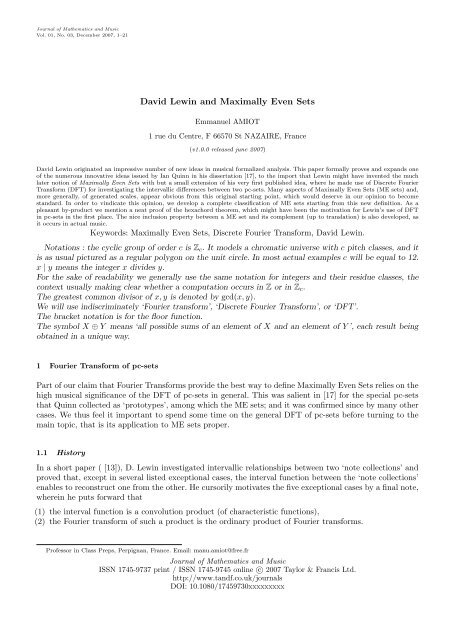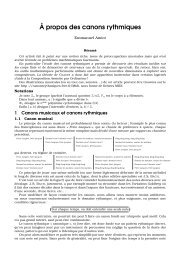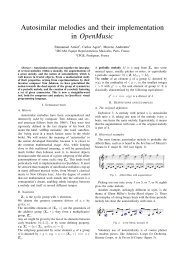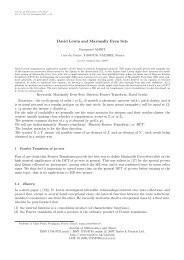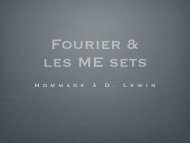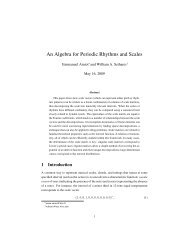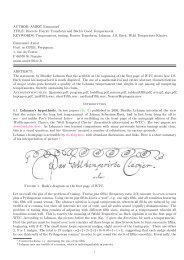Emmanuel Amiot Modèles algébriques et algorithmes pour la ...
Emmanuel Amiot Modèles algébriques et algorithmes pour la ...
Emmanuel Amiot Modèles algébriques et algorithmes pour la ...
You also want an ePaper? Increase the reach of your titles
YUMPU automatically turns print PDFs into web optimized ePapers that Google loves.
Journal of Mathematics and Music<br />
Vol. 01, No. 03, December 2007, 1–21<br />
David Lewin and Maximally Even S<strong>et</strong>s<br />
<strong>Emmanuel</strong> AMIOT<br />
1 rue du Centre, F 66570 St NAZAIRE, France<br />
(v1.0.0 released june 2007)<br />
David Lewin originated an impressive number of new ideas in musical formalized analysis. This paper formally proves and expands one<br />
of the numerous innovative ideas issued by Ian Quinn in his dissertation [17], to the import that Lewin might have invented the much<br />
<strong>la</strong>ter notion of Maximally Even S<strong>et</strong>s with but a small extension of his very first published idea, where he made use of Discr<strong>et</strong>e Fourier<br />
Transform (DFT) for investigating the intervallic differences b<strong>et</strong>ween two pc-s<strong>et</strong>s. Many aspects of Maximally Even S<strong>et</strong>s (ME s<strong>et</strong>s) and,<br />
more generally, of generated scales, appear obvious from this original starting point, which would deserve in our opinion to become<br />
standard. In order to vindicate this opinion, we develop a compl<strong>et</strong>e c<strong>la</strong>ssification of ME s<strong>et</strong>s starting from this new definition. As a<br />
pleasant by-product we mention a neat proof of the hexachord theorem, which might have been the motivation for Lewin’s use of DFT<br />
in pc-s<strong>et</strong>s in the first p<strong>la</strong>ce. The nice inclusion property b<strong>et</strong>ween a ME s<strong>et</strong> and its complement (up to trans<strong>la</strong>tion) is also developed, as<br />
it occurs in actual music.<br />
Keywords: Maximally Even S<strong>et</strong>s, Discr<strong>et</strong>e Fourier Transform, David Lewin.<br />
Notations : the cyclic group of order c is Zc. It models a chromatic universe with c pitch c<strong>la</strong>sses, and it<br />
is as usual pictured as a regu<strong>la</strong>r polygon on the unit circle. In most actual examples c will be equal to 12.<br />
x | y means the integer x divides y.<br />
For the sake of readability we generally use the same notation for integers and their residue c<strong>la</strong>sses, the<br />
context usually making clear wh<strong>et</strong>her a computation occurs in Z or in Zc.<br />
The greatest common divisor of x, y is denoted by gcd(x, y).<br />
We will use indiscriminately ‘Fourier transform’, ‘Discr<strong>et</strong>e Fourier Transform’, or ‘DFT’.<br />
The brack<strong>et</strong> notation is for the floor function.<br />
The symbol X ⊕ Y means ‘all possible sums of an element of X and an element of Y ’, each result being<br />
obtained in a unique way.<br />
1 Fourier Transform of pc-s<strong>et</strong>s<br />
Part of our c<strong>la</strong>im that Fourier Transforms provide the best way to define Maximally Even S<strong>et</strong>s relies on the<br />
high musical significance of the DFT of pc-s<strong>et</strong>s in general. This was salient in [17] for the special pc-s<strong>et</strong>s<br />
that Quinn collected as ‘prototypes’, among which the ME s<strong>et</strong>s; and it was confirmed since by many other<br />
cases. We thus feel it important to spend some time on the general DFT of pc-s<strong>et</strong>s before turning to the<br />
main topic, that is its application to ME s<strong>et</strong>s proper.<br />
1.1 History<br />
In a short paper ( [13]), D. Lewin investigated intervallic re<strong>la</strong>tionships b<strong>et</strong>ween two ‘note collections’ and<br />
proved that, except in several listed exceptional cases, the interval function b<strong>et</strong>ween the ‘note collections’<br />
enables to reconstruct one from the other. He cursorily motivates the five exceptional cases by a final note,<br />
wherein he puts forward that<br />
(1) the interval function is a convolution product (of characteristic functions),<br />
(2) the Fourier transform of such a product is the ordinary product of Fourier transforms.<br />
Professor in C<strong>la</strong>ss Preps, Perpignan, France. Email: manu.amiot@free.fr<br />
Journal of Mathematics and Music<br />
ISSN 1745-9737 print / ISSN 1745-9745 online c○ 2007 Taylor & Francis Ltd.<br />
http://www.tandf.co.uk/journals<br />
DOI: 10.1080/17459730xxxxxxxxx


